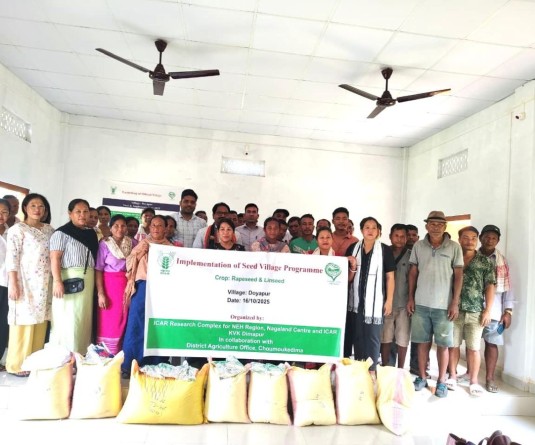
Mustard belongs to the genera Brassica and the family Brassicaceae. Mustard is self-pollinated, but cross-pollination also takes place to some extent. It is also known as rai, raya or laha. Mustard is an annual herb with seedlings that emerge rapidly, but then usually grow slowly. Plants cover the ground in four to five weeks with favorable moisture and temperature conditions. Tap roots will grow 5 feet into the soil under dry conditions, which allows for efficient use of stored soil moisture. Plant height at maturity varies from 76 to 115cm. depending on type, variety, and environmental conditions.
Leaves are not dilated at the base and clasping as in the case of rape, but are stalked, broad and pinnatified. Siliqua are slender and only 2.0-6.5cm long strongly ascending or erect with short and stout beaks. Colour of seed is brown or dark brown. Seed coat is rough. Flower buds are visible about five weeks after emergence. Yellow flowers begin to appear 7 to10 days later and continue blooming for a longer period with an adequate water supply. A longer flowering period increases the yield potential. About half of the flowers produce dark, reddish-brown seeds that are retained in pods of 0.5 to 0.75 in. in length. Flowers pollinated during the first 15 days of the flowering period produce most of the seed.
Climatic requirements: Mustard is a crop of temperate climates, but can also be cultivated at higher elevations in the tropics. Crop requires about 18-25ºC temperature, low humidity, practically no rains especially at the time of flowering. Crop growth is optimum at <25ºC, while it ceases at <3 and >35ºC. Rainfall, high humidity and cloudy weather are not favourable for the crop during winter; as such conditions would invite aphids. However, under rainfed conditions, one or two pre-flowering rains help in boosting the grain yield. Excessive cold and frost are harmful to the crop. Mustard is a long day in photo-periodic response. It requires an annual precipitation of 40-100 cm. Mustard cannot tolerate waterlogging.
Soils: Generally mustard thrive best in medium or heavy loam soils. Very light soils usually cause a severe moisture stress resulting in a poor crop growth. Soils with an electrical conductivity (EC) of >4 dS/m and exchangeable sodium percentage (ESP) > 15% are not suitable. Soils with pH <5.0 and >9.0 are not suitable for these crops. Soils having pH 6.0-7.5 is ideal for their proper growth and development.
Land preparation: Mustard requires a fine, firm, moist seed-bed so that adequate moisture is assured for germinating seeds and young seedlings. To achieve this, field should be given one pre-sowing irrigation. Field should be given a deep ploughing soon after the kharif crop. Thereafter, it may be ploughed 3-4 times with country plough followed by planking after each ploughing. Weeds and stubbles should be removed from the field.
Seed Rate and Spacing: Maintenance of optimum plant population is essential for getting good harvests. Spacing has no absolute value in the cultivation of mustard as it fluctuates a great deal with the growth habit of variety, date of sowing, manuring and irrigation practices. Generally mustard are sown in rows 45 cm apart. In case of mixed cropping they are generally sown in rows 1.8 to 2.4 meters apart in the main crop. 5 to 6 kg seed per hectare should be sown in rows in case of a pure crop. When sown mixed with some other crop, 1.5 to 2 kg seed per hectare is sufficient.
Thinning: Crop should be thinned 15-20 days after sowing to maintain plant-to-plant distance of 10-15 cm.
Seed Treatment: Before sowing seed should be treated with thiram or captan @ 2.5 g/kg of seed. An integrated disease management strategy for white-rust affected areas to control leaf and stag head phases of the rust includes seed treatment with apron 355D at 6 g/kg of seed.
Time of Sowing: Sowing is to be done when maximum temperature is around 30ºC. If the temperature is high, sowing could be delayed. Optimum time of sowing is middle of October to first week of November.
Sowing Practices: Under dryland conditions, seed should be sown in furrows with ridge seeder for maintaining a perfect crop stand and better conservation of moisture. While sowing, care should be taken that the seed does not come in contact with drilled fertilizer as it affects germination. Seed should be sown at a depth of 2.5-3.0 cm, whereas fertilizer should be drilled at 7-10 cm depth. To ensure good germination and early seedling vigour, seed must be soaked in water before sowing. This is best done by covering the seeds with a moist gunny bag or directly with damp earth overnight.
Manures and Fertilizers: Mustard responds well both to organic and inorganic manures. If available, apply 15-20 tonnes/ha of FYM or compost at the time of field preparation. Crop is very sensitive to nitrogen nutrition. Nitrogenous fertilizer in the form of ammonium sulphate is beneficial for the crop. Effect of N fertilizer can be optimized by combining soil and foliar application. Half of the recommended dose must be applied (preferably drilled) at the time of sowing. Remaining half must be applied in the form of foliar spray (1.5-2.0% high volume or 10-15% low volume micronet-35 sprayer). First spray should be given at the time of flower initiation. Dose of 40 kg N/ha as soil application and 20 kg N/ha as foliar spray proves as good as 80 kg N/ha applied to soil. This method saves 25% of the N fertilizer without affecting the yield. Recommended rate of NPK for North-eastern Hilly region is 50:30:30. Mustard should be supplied with 20 kg sulphur and 1 kg boron/ha as basal dose, wherever the deficiency of these nutrients is noticed.
Water management: Mustard requires about 30-40 cm of water and the consumptive use of water varies from 200-300 mm. In general, mustard crop requires 2 irrigations; first at branching stage (30 DAS) and the second at pod formation stage (60-65 DAS).
Weed control: Most common weeds of mustard crop are Chenopodium album (bathua), Lathyrus spp. (chatrimatri), Melilotus indica (senji), Cirsium arvense (kateli), Cyperus rotundus (motha) and Fumaria parviflora (gajri). Initial 45-60 days after sowing is critical period of crop weed competition. Uncontrolled weeds in these crops may cause 20-70% reduction in yield. Weeding should be done soon after thinning. This, besides creating soil mulch and reducing moisture losses, helps in better growth and proper development of crop plants. Under rain fed conditions, one hand weeding 25 DAS, while under irrigated conditions, 2 hand weedings 25 and 40 DAS are necessary for effective weed control. Pre-plant incorporation of fluchloralin @ 1.00 kg/ha or pre-emergence application of pendimethalin @ 1.00 kg/ha are quite effective in controlling weeds. If the weeds emerge after planting, isoproturon @ 0.75 kg/ha may be sprayed 30 days after sowing. Application of nitrofen @ 1.0 to 1.5 kg/ha in 800-1000 liters of water as pre-emergence spray is also found effective to control the weeds.
Recommended varieties for north-eastern states: Pusa Mahak (JD-6), Pusa Agrani (SEJ-2), Pusa Aditya (NPC- 9).
Harvesting and threshing: Usually mustard crops are harvested as soon as pods turn yellowish and moisture content of seed is around 40%. Crop should be harvested preferably in the morning hours, when the pods are slightly damp with night dew to minimize the shattering losses.
Bundles of harvested plants are to be staked and dried in the sun for a few days. Threshing is to be done by the usual method of threshing by bullocks or running a tractor over the dried plants. Seeds are separated by winnowing. Moisture content of the seed must be less than 8% at the storage time.
Yield: Under normal conditions, mustard seed yield is 2.0-2.5 tonnes/ha and Oil % in mustard seed is 38-40%.
Average yield in various conditions:
Mixed crop - 2-3 q/ha
Pure crop - 10-15 q/ha
The article is contributed by Bendangla Imsong, ACTO (Plant Breeding) and Santosh Kr Baishya, Senior Scientist & Head, KVK Wokha, ICAR Nagaland Centre.






